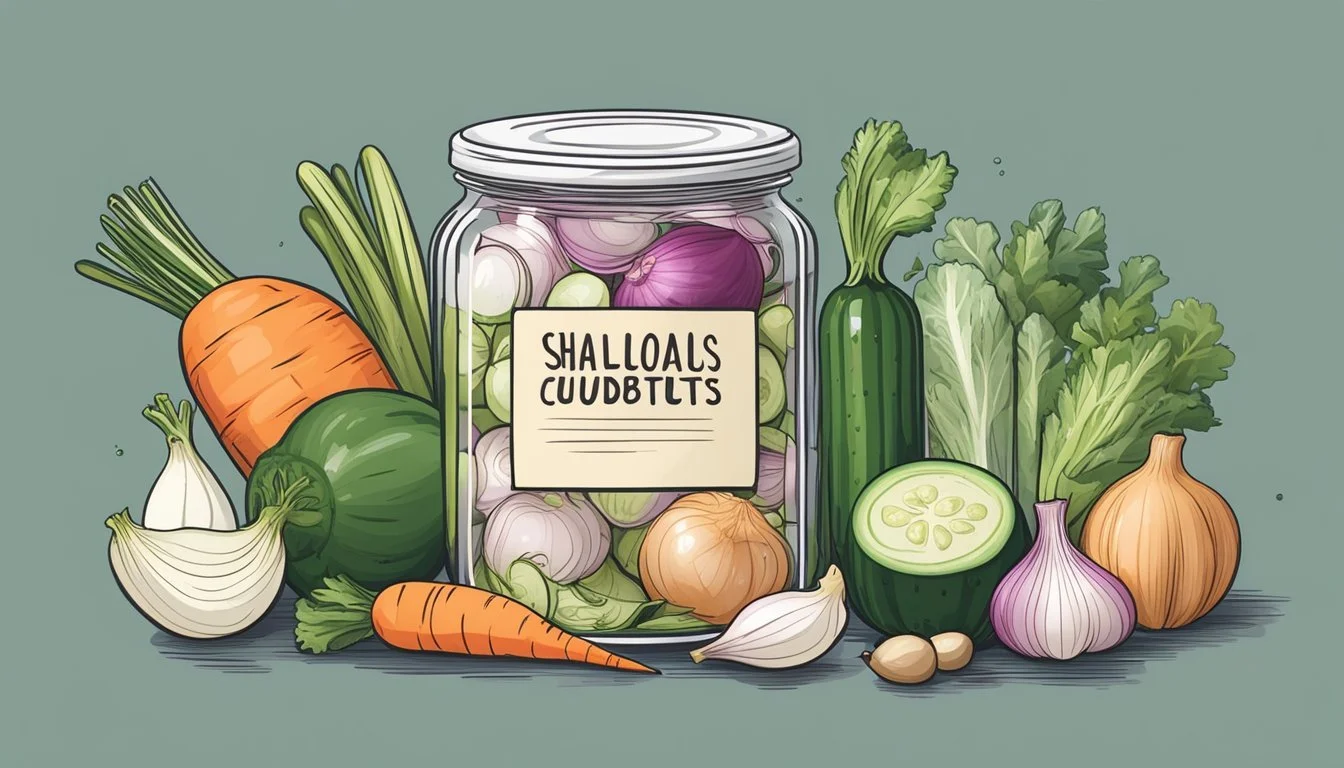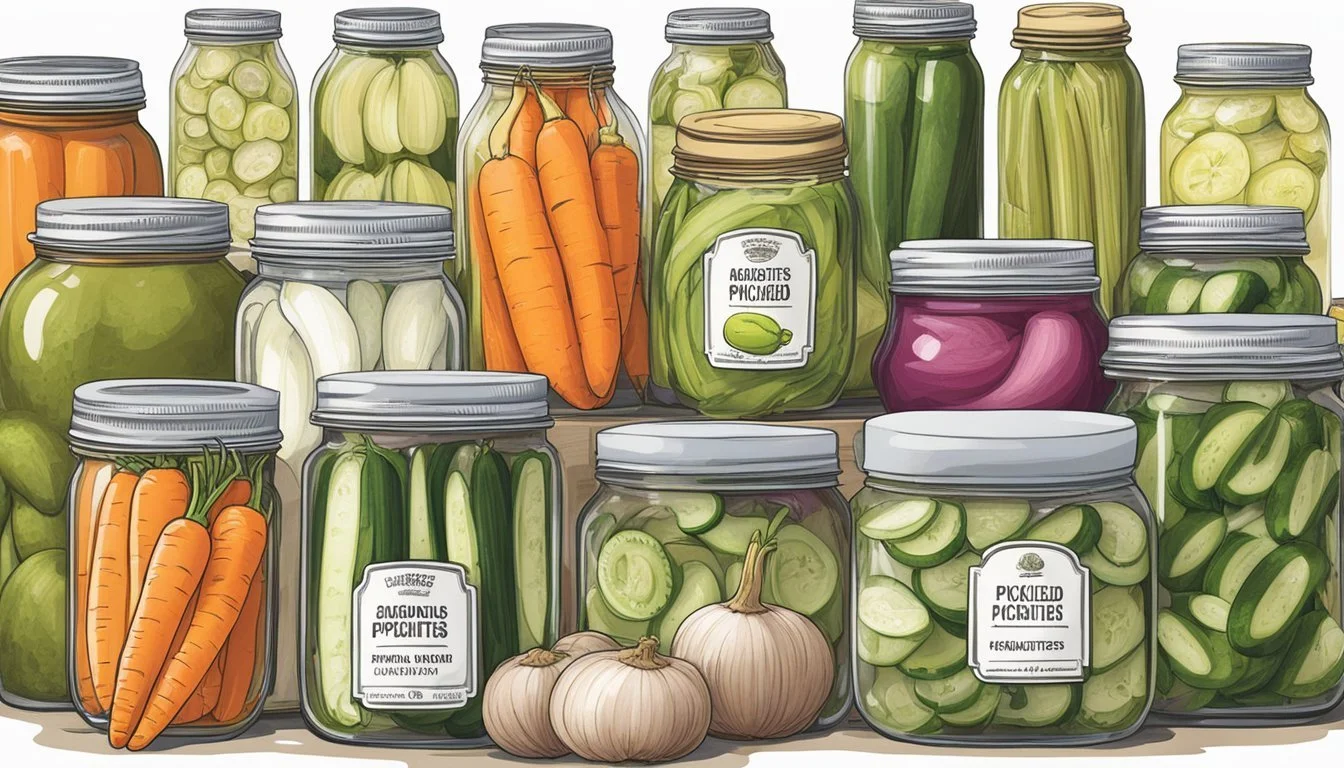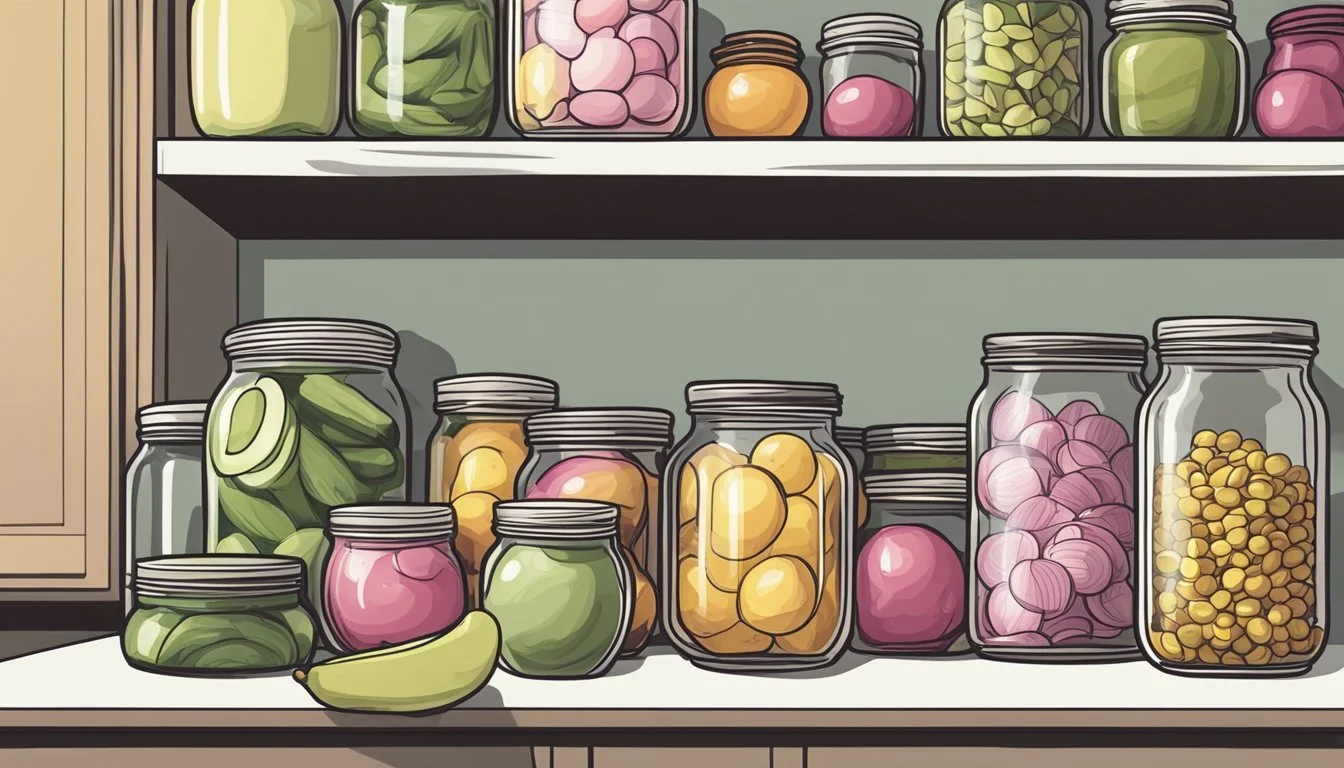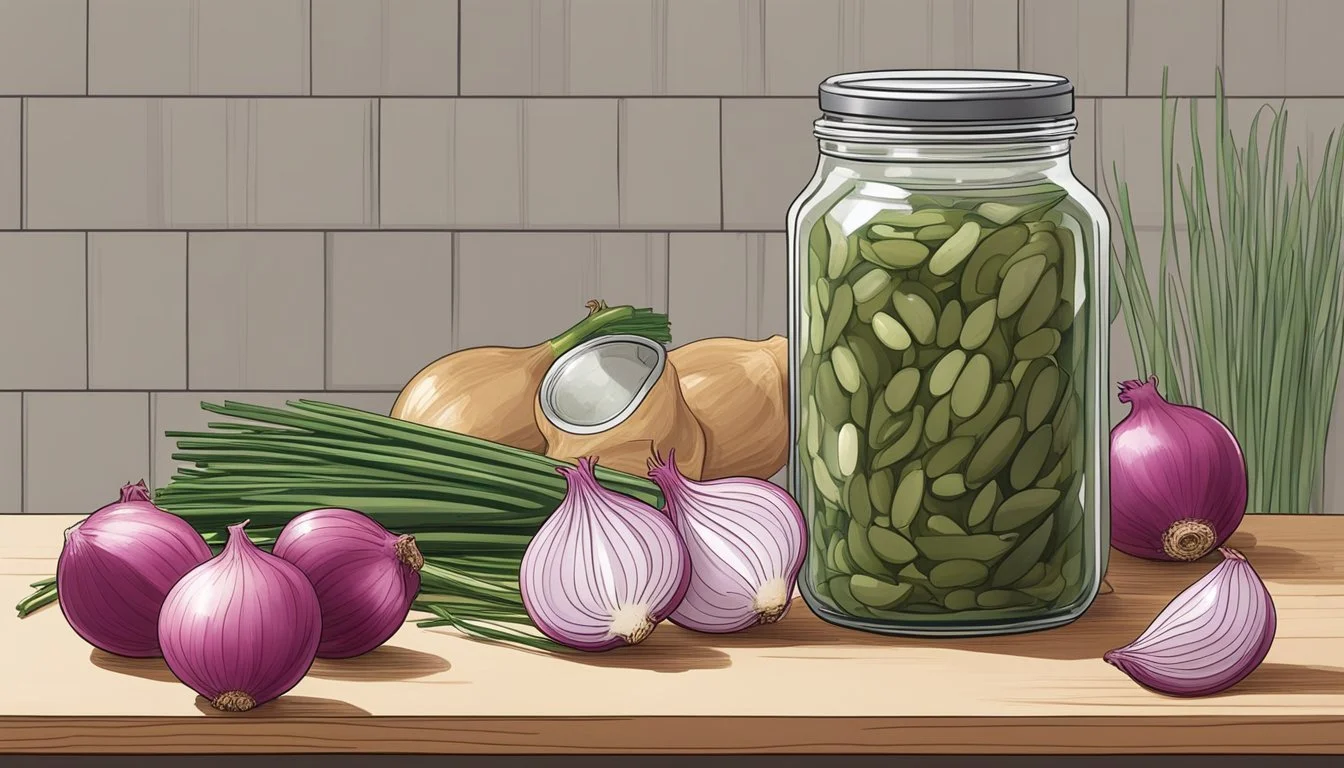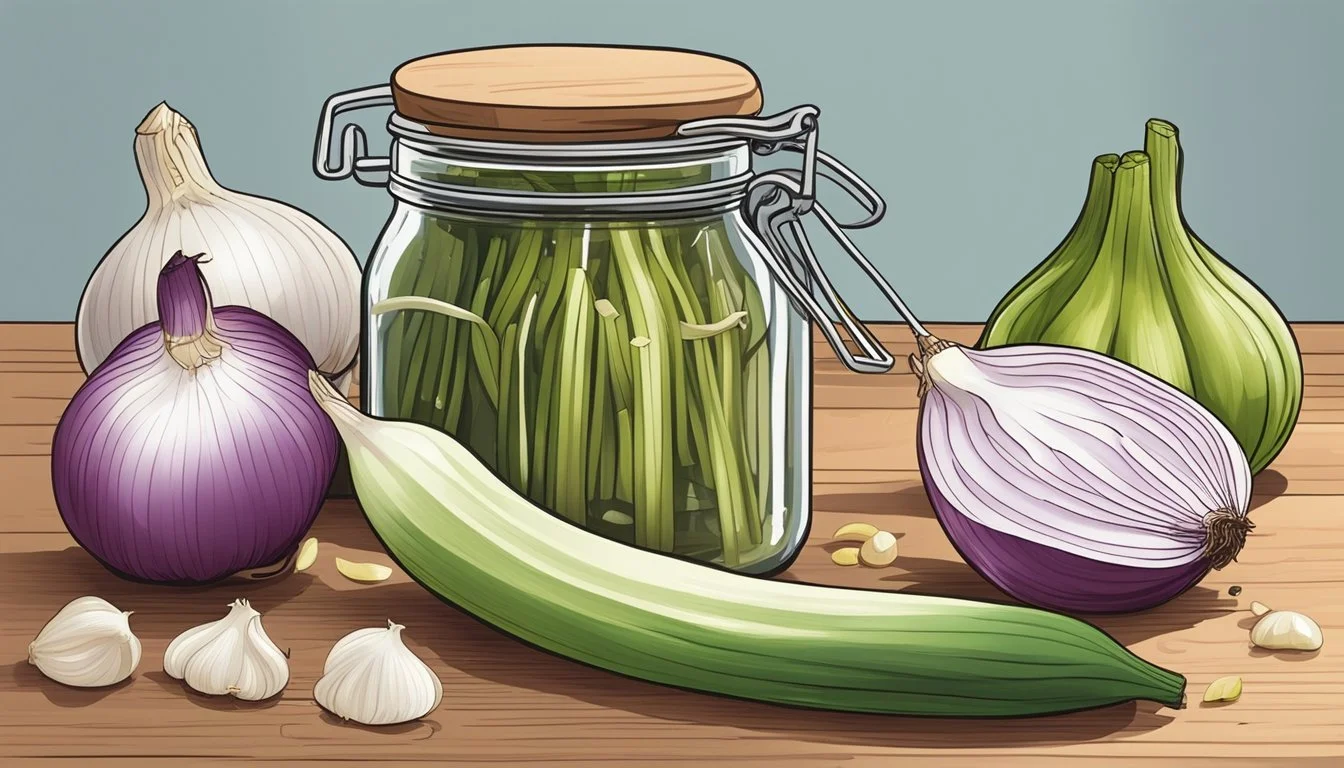Pickled Onions Substitutes
Best Alternatives for Any Recipe
For those who love the tangy, sweet punch of pickled onions, finding an appropriate substitute can be crucial for maintaining flavor in recipes. Whether you’ve run out or simply can’t find them, several alternatives can stand in admirably. One of the best substitutes is pickled pearl onions, which offer a similar texture and a mild, sweet flavor that closely mirrors pickled red onions.
Green onions or scallions, when pickled, can also bring a refreshing, mild sharpness to dishes. They offer the benefit of ease of pickling, allowing customization of the flavor profile to better suit specific culinary needs. Another excellent option is using chopped fennel bulbs, which impart an anise-like sweetness, balancing the flavors in a unique and aromatic way.
Some non-pickled alternatives include using fresh red onions with a touch of vinegar, which can mimic the acidity of pickled onions. Even using fresh leeks or celery stalks in a quick pickling solution can offer surprising depth and versatility. With these substitutes, maintaining the desired flavor and enhancing the versatility of various recipes becomes a straightforward task.
Understanding Pickled Onions
Pickled onions are more than a tangy addition to meals; they involve a nuanced blend of ingredients, offer diverse culinary applications, and possess certain health attributes that should be acknowledged.
Composition and Flavor Profile
The composition of pickled onions typically includes onions, vinegar, salt, and often sugar or other spices. These ingredients create a balance of tangy, salty, and sometimes sweet flavors.
The onions are soaked in a vinegar solution, which can vary in strength. This results in a more subtle flavor for cocktail onions or a robust taste for traditional pickled onions.
Different types of onions like red, pearl, and white can be used, each contributing a unique texture and taste.
Culinary Uses
Pickled onions can enhance a variety of dishes. They are often used as toppings for tacos, burgers, and hot dogs, adding a crisp and tangy crunch.
In salads, they provide a bright contrast to fresh greens and creamy dressings. Chefs might also incorporate them into sandwiches, where their acidity cuts through rich ingredients like cheese and meats.
They are versatile enough to be served as a side dish or garnish, making them a valued ingredient in numerous cuisines.
Health Considerations
Pickled onions offer some health benefits along with considerations. They are low in calories and can provide small amounts of vitamins and minerals.
The fermentation process might offer probiotic benefits, although this greatly depends on the method used. On the downside, they can be high in sodium due to the salt used in the pickling process.
It's essential to consume them in moderation, especially for individuals with hypertension or those monitoring their salt intake. The vinegar in the pickling solution may also have beneficial effects on blood sugar levels.
Criteria for Suitable Substitutes
When selecting substitutes for pickled onions, there are several important factors to consider to ensure that the replacement ingredient meets the expectations of the original in terms of flavor, texture, and visual appeal.
Flavor Compatibility
Flavor is a critical aspect when replacing pickled onions. The substitute should ideally offer a similar balance of tanginess and sweetness. For instance, pickled pearl onions provide a sweet and mild flavor which can closely mimic the taste of pickled onions. Green onions (scallions) and shallots can also work well, offering a less pungent and more subtle flavor which may complement the dish differently but still effectively. It is important to adjust the quantity used to maintain the desired flavor profile.
Texture Considerations
Texture plays a significant role in how a substitute performs in a dish. Pickled onions have a firm, yet yielding texture. A good substitute should replicate this crunch. Celery stalks and fennel bulbs are good candidates as they maintain a similar crisp texture when chopped. For diced substitutes, leeks can provide a good textural match when finely chopped, although they may be slightly softer. Balancing the texture ensures that the dish retains the desired mouthfeel.
Visual Appeal
The color and appearance of the substitute should also be taken into account. Pickled onions typically have a distinct pink or purple hue. Red cabbage or beetroot slices pickled in vinegar can achieve a similar color. This visual match preserves the enticing look of the dish. White onions or yellow onions can be used, but they might lack the vivid color. Garnishing with fresh herbs can also help to maintain the visual charm of the dish.
Carefully considering these aspects ensures that the substitute used for pickled onions maintains the integrity and appeal of the original dish, delivering an equally satisfying culinary experience.
Common Onion Substitutes
When you find yourself out of onions or catering to preferences, several alternatives can replicate both the unique taste and texture of onions. Each substitute offers specific benefits, and understanding their differences can better inform your cooking decisions.
Shallots and Green Onions
Shallots offer a delicate and mildly sweet flavor. They have a similar texture to onions, making them an excellent substitute in dishes that require finely chopped onions. Shallots are particularly useful in raw applications like salads and vinaigrettes, as their subdued taste won't overpower.
Green onions, including scallions, provide a more potent, yet still subtle, onion flavor. Their tender green tops can be used for garnish, while the white bulbs offer a crisp texture. Green onions work well in stir-fries, soups, and fresh salsas.
Leek and Chives
Leeks have a milder taste than most onions and can be used in larger quantities without overwhelming a dish. The mild, oniony garlic flavor of leeks is perfect for soups, stews, and casseroles. Make sure to thoroughly clean leeks, as dirt often hides between their layers.
Chives offer a fresh, light onion flavor and are best used fresh. They are ideal for sprinkling over potatoes, fish, or eggs. Since chives lose their flavor when cooked for too long, they should be added at the end of the cooking process or used as a garnish.
Red and White Onions
Red onions are sweet and slightly peppery, making them great in salads, salsas, and pickled preparations. Their vibrant color also adds a visual appeal to dishes. Red onions can also be grilled or roasted, which mellows their sharpness.
White onions have a high water content and a strong, clean flavor. They are commonly used in Mexican cuisine and work perfectly in dishes where the onion flavor should stand out, such as guacamole, pico de gallo, and ceviche.
Yellow Onions and Scallions
Yellow onions are perhaps the most versatile of all onion substitutes. They offer a balanced sweetness and acidity, making them suitable for a wide range of dishes, from soups and stews to caramelized onions. When cooked, they develop a rich, savory flavor that enhances the depth of any recipe.
Scallions, sometimes confused with green onions, have a slightly stronger flavor. They are ideal for adding both color and taste when used fresh as a garnish. Additionally, scallions can be grilled or sautéed to add a mild onion flavor to cooked dishes.
Non-Onion Alternatives
Those looking to avoid onions but still add flavor and texture to their dishes can turn to various vegetables. Options like bell peppers, carrots, fennel, celery, ginger, and cabbage offer distinct tastes and culinary flexibility.
Bell Peppers and Carrots
Bell peppers provide a sweet, slightly tangy taste that can enhance many dishes. They are available in various colors, each with a slightly different flavor profile.
Red bell peppers are the sweetest, while green ones are more pungent. Use them raw in salads or cooked in stir-fries or sauces.
Carrots add sweetness and a crunchy texture. When used raw, they are refreshing in salads. Cooked carrots soften and develop a richer, sweeter flavor, making them perfect for soups and stews.
Fennel and Celery
Fennel has a unique licorice flavor, which makes it a standout in dishes. Its anise-like taste can complement both savory and sweet recipes.
Sliced raw fennel bulb is excellent in salads, providing crunch and zest. Cooked fennel mellows and blends well in roasts and braises.
Celery adds a subtle, slightly peppery taste with a crisp texture. It is commonly used in soups and stews to add depth of flavor.
Raw celery is ideal for salads and appetizers. Cooked celery softens and infuses dishes with its mild flavor, making it a versatile cooking ingredient.
Ginger and Cabbage
Ginger offers a sharp, pungent taste that can invigorate any dish. Fresh ginger is zesty and aromatic, making it ideal for both sweet and savory dishes.
Grating fresh ginger into dressings, marinades, or stir-fries adds a fresh, spicy kick. Dried ginger powder is less intense but still effective for baking and cooking.
Cabbage provides a crunchy texture and mild peppery taste. It is highly versatile, suitable for both raw and cooked applications.
Shredded raw cabbage is crispy and slightly peppery, perfect for coleslaws and salads. Cooked cabbage, such as in stir-fries or braises, becomes tender and absorbs surrounding flavors well. This makes it a good addition to a variety of dishes.
Pickling Other Vegetables
Pickling isn't just limited to onions; a variety of other vegetables can be transformed with the right techniques and ingredients. Pearl onions, carrots, cabbage, and red bell peppers are excellent choices for pickling due to their unique flavors and textures.
Pearl Onions and Carrots
Pearl onions and carrots make a delightful addition to any pickled assortment. To prepare pearl onions, blanch them briefly to make peeling easier. Carrots should be cut into manageable sticks or rounds.
In a saucepan, combine water, vinegar, sugar, and a mix of spices such as bay leaf, thyme, or allspice. Bring to a boil and pour over the vegetables in sterilized jars. Ensure the vegetables are fully submerged in the pickling solution. Let the jars cool to room temperature before storing them in the refrigerator. These pickled vegetables make a crunchy, tangy snack.
Cabbage and Red Bell Peppers
Cabbage and red bell peppers are vibrant choices for pickling, adding both color and crunch. Shred the cabbage finely and chop the red bell peppers into thin strips. Salt the vegetables to draw out moisture, then let them sit for a few hours before draining.
In a large pot, mix vinegar, water, sugar, and spices like mustard seed or turmeric. Bring this mixture to a boil. Pack the cabbage and red bell peppers into jars and pour the hot pickling liquid over them. After sealing the jars, store them in a cool, dark place. These pickled vegetables are perfect for garnishing sandwiches or adding to salads.
Usage Tips for Onion Substitutes
When replacing pickled onions, understanding the nuances of sweetness and heat, as well as how to balance flavors in dishes, is crucial. This knowledge ensures substitutes don't overpower or underwhelm the recipe.
Adjusting for Sweetness and Heat
Sweet onions such as Vidalia or Walla Walla can be used as substitutes. To match the mild sweetness of pickled onions, these are ideal. Add them to sandwiches, salads, or soups. A ratio of 1:1 often works, but taste and adjust as you go.
For heat, alternatives like minced or dried onion flakes work. Use sparingly in sauces or stews, as their concentrated flavor can quickly overpower a dish. Combine with bell peppers or celery for texture and to mellow the heat.
Here’s a quick guide:
Substitute Ratio Notes Sweet Onion 1:1 Ideal for milder flavor Minced Onion Flake 1 tsp per small onion Stronger, use carefully Scallions 1:1, 6-8 per onion Mild, great for salads
Balancing Flavors in Dishes
Balancing flavors is key when using substitutes. Shallots offer a subtle, complex flavor fitting for risottos and soups. Cut them similarly to onions and sauté them to release their mild sweetness.
Leeks add a delicate touch. Use them in vegetable dishes and sauces. Cook them thoroughly to soften their strong initial taste. Mix with other vegetables to achieve a balanced profile.
In sandwiches, green onions provide a fresh taste that isn’t too pungent. They complement other ingredients without overpowering them. Use around 6 to 8 medium green onions for a medium pickled onion’s worth.
By carefully adjusting for sweetness and heat and minding the balance, these substitutes ensure your dishes retain their intended flavor profiles.
Navigating Onion Allergies
For those who have allergies to onions and other members of the allium family, finding suitable substitutes that maintain flavor and texture in dishes is crucial. Identifying allium-free options and making culinary adjustments helps manage these allergies while still enjoying a variety of flavorful meals.
Identifying Allium-Free Options
Identifying substitutes for onions that don't belong to the allium family is essential. Common non-allium options include bell peppers, carrots, and celery. These vegetables can provide a crunchy texture and mild sweetness similar to onions without triggering an allergic reaction.
Additionally, fennel offers a slightly sweet, anise-like flavor and a pleasant crunch. It's a balanced substitute in many recipes. To achieve a savory depth, try using grated horseradish or ginger. Both add a nuanced kick without any risk of allergen exposure.
Culinary Adjustments for Allergies
Adjusting recipes to exclude onions requires careful selection and proportioning of substitutes. For salads and raw dishes, finely chopped cucumber or radishes work well to replace the crunch of raw onions. In cooked dishes, leeks or shallots can be used sparingly, but only if they don't trigger an allergic reaction.
Flavor-wise, the umami richness onions provide can be mimicked with a blend of soy sauce and miso paste. This combination adds depth to soups and sauces. To replicate the savory profile, experiment with mushroom powder or a pinch of asafoetida to the dish.
Incorporating these substitutes effectively ensures that those with onion allergies can enjoy diverse, flavorful meals without compromising their health.
Creative Cooking with Onion Substitutes
Experimenting with onion substitutes can lead to unique culinary experiences. These substitutes can be used to enhance flavors in various dishes, from everyday meals to international cuisine.
Innovative Flavor Combinations
Incorporating substitutes for onions, such as leeks, shallots, and green onions, can create exciting new flavor profiles. Leeks, with their mild, onion-garlic essence, work exceptionally well in soups and stews, adding depth without overpowering the dish.
Shallots bring a gentle sweetness, making them perfect for salads, dressings, and gourmet sandwiches. Use 1 large shallot for every half cup of onion required.
Green onions, or scallions, provide a fresh, crisp taste, ideal for tacos, burgers, and stir-fries. Use around 6-8 medium green onions to replace one medium onion.
Substitutes in Global Cuisines
Different onion substitutes can shine in various global dishes. For example, Chinese onions are excellent in Asian cuisine, especially when pickled, adding a tangy crunch to meals like stir-fried noodles and rice dishes.
In Mediterranean cooking, finely chopped leeks complement roasted vegetables and meat dishes. They bring a subtle yet sophisticated flavor that enhances the dish's complexity.
Using shallots in French cuisine brings out the best in sauces and marinades. Their delicate taste melds beautifully with herbs and spices, enriching the overall flavor.
These substitutes are versatile, allowing cooks to customize dishes while maintaining or even enhancing the intended flavors.


